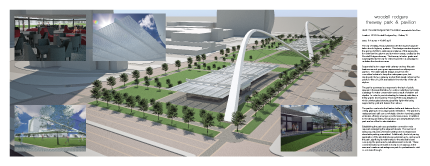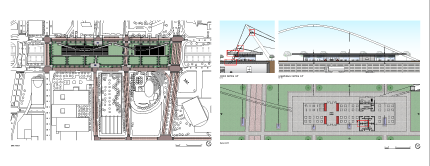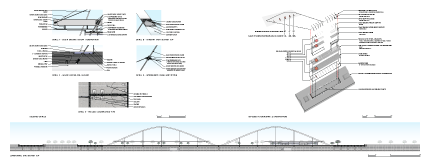woodall rodgers
freeway park & pavilion
client: Woodall Rodgers Park Foundation represented by Kevin Sloan
location: 2012 Woodall Rodgers Fwy. Dallas, TX
area: 5.4 acres + 10,495 sq ft
The city of Dallas, Texas is familiar with the result of segmentation due to highway systems. This design was developed in the spring of 2009 to address an instance of this segmentation between the uptown and downtown areas, created by the Woodall Rodgers freeway. The freeway is below grade and was targeted by the city for redevelopment in a campaign to revitalize the downtown area.
Suspended by two segmental catenary arches, this park features several open green spaces and a multipurpose pavilion. The cable-stayed design arose from the committee’s desire to keep the underpass open, but developed into two gateway arches that visually reference the public to this civic joint and adds to the notoriety of the city skyline.
The park’s openness is a response to the lack of public spaces in the area that allow for outdoor activities, but is also a strategy for water conservation and a result of shallow soil depths. In order to provide shading for leisurely activities, a trellis system developed by Thomas Phifer was adapted, in which uninterrupted slender pipes filter light while being supported by joist and beams from above.
The pavilion rest under the Eastern trellis and features floor to ceiling glazing to encourage public interaction. The pavilion’s restaurant and café can comfortably dine two hundred guests while also offering a lounge or performance area. In addition to the dining amenities, the structure provides facilities for the park and an office for administration.
Establishing the park as a pedestrian connection node required redesigning the adjacent streets. The number of lanes was reduced, while lane widths were increased and street side parking was added. Additionally, the brick paving application of the arts district was extended up to, and around the park, signifying its relationship to the arts district and conveying the park area to pedestrians and motorist. These combined actions will make motorist more cautious in the area and create an advantageous park for pedestrians to visit or commute through.


